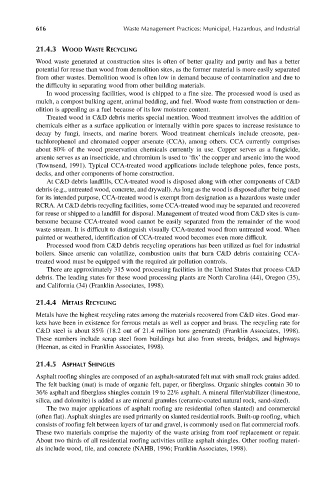Page 645 - Materials Chemistry, Second Edition
P. 645
CAT3525_C21.qxd 1/27/2005 12:56 PM Page 616
616 Waste Management Practices: Municipal, Hazardous, and Industrial
21.4.3 WOOD WASTE RECYCLING
Wood waste generated at construction sites is often of better quality and purity and has a better
potential for reuse than wood from demolition sites, as the former material is more easily separated
from other wastes. Demolition wood is often low in demand because of contamination and due to
the difficulty in separating wood from other building materials.
In wood processing facilities, wood is chipped to a fine size. The processed wood is used as
mulch, a compost bulking agent, animal bedding, and fuel. Wood waste from construction or dem-
olition is appealing as a fuel because of its low moisture content.
Treated wood in C&D debris merits special mention. Wood treatment involves the addition of
chemicals either as a surface application or internally within pore spaces to increase resistance to
decay by fungi, insects, and marine borers. Wood treatment chemicals include creosote, pen-
tachlorophenol and chromated copper arsenate (CCA), among others. CCA currently comprises
about 80% of the wood preservation chemicals currently in use. Copper serves as a fungicide,
arsenic serves as an insecticide, and chromium is used to ‘fix’ the copper and arsenic into the wood
(Townsend, 1991). Typical CCA-treated wood applications include telephone poles, fence posts,
decks, and other components of home construction.
At C&D debris landfills, CCA-treated wood is disposed along with other components of C&D
debris (e.g., untreated wood, concrete, and drywall). As long as the wood is disposed after being used
for its intended purpose, CCA-treated wood is exempt from designation as a hazardous waste under
RCRA. At C&D debris recycling facilities, some CCA-treated wood may be separated and recovered
for reuse or shipped to a landfill for disposal. Management of treated wood from C&D sites is cum-
bersome because CCA-treated wood cannot be easily separated from the remainder of the wood
waste stream. It is difficult to distinguish visually CCA-treated wood from untreated wood. When
painted or weathered, identification of CCA-treated wood becomes even more difficult.
Processed wood from C&D debris recycling operations has been utilized as fuel for industrial
boilers. Since arsenic can volatilize, combustion units that burn C&D debris containing CCA-
treated wood must be equipped with the required air pollution controls.
There are approximately 315 wood processing facilities in the United States that process C&D
debris. The leading states for these wood processing plants are North Carolina (44), Oregon (35),
and California (34) (Franklin Associates, 1998).
21.4.4 METALS RECYCLING
Metals have the highest recycling rates among the materials recovered from C&D sites. Good mar-
kets have been in existence for ferrous metals as well as copper and brass. The recycling rate for
C&D steel is about 85% (18.2 out of 21.4 million tons generated) (Franklin Associates, 1998).
These numbers include scrap steel from buildings but also from streets, bridges, and highways
(Heenan, as cited in Franklin Associates, 1998).
21.4.5 ASPHALT SHINGLES
Asphalt roofing shingles are composed of an asphalt-saturated felt mat with small rock grains added.
The felt backing (mat) is made of organic felt, paper, or fiberglass. Organic shingles contain 30 to
36% asphalt and fiberglass shingles contain 19 to 22% asphalt. A mineral filler/stabilizer (limestone,
silica, and dolomite) is added as are mineral granules (ceramic-coated natural rock, sand-sized).
The two major applications of asphalt roofing are residential (often slanted) and commercial
(often flat). Asphalt shingles are used primarily on slanted residential roofs. Built-up roofing, which
consists of roofing felt between layers of tar and gravel, is commonly used on flat commercial roofs.
These two materials comprise the majority of the waste arising from roof replacement or repair.
About two thirds of all residential roofing activities utilize asphalt shingles. Other roofing materi-
als include wood, tile, and concrete (NAHB, 1996; Franklin Associates, 1998).

